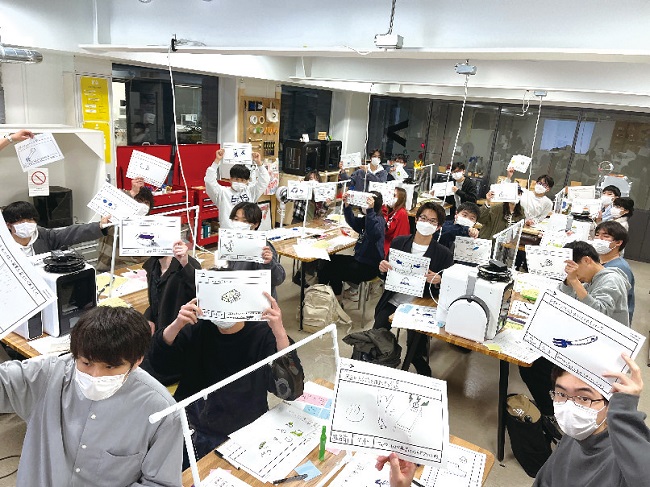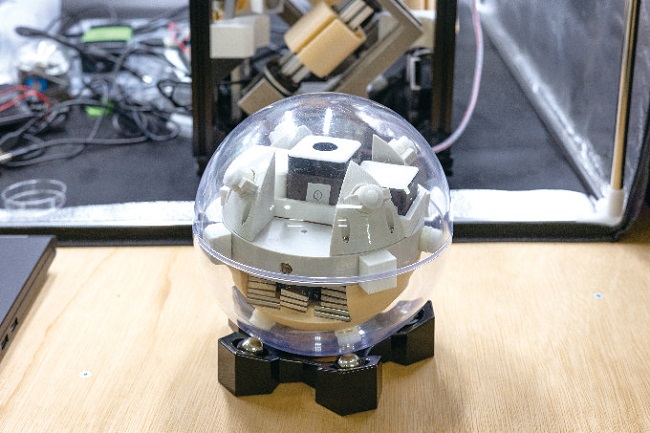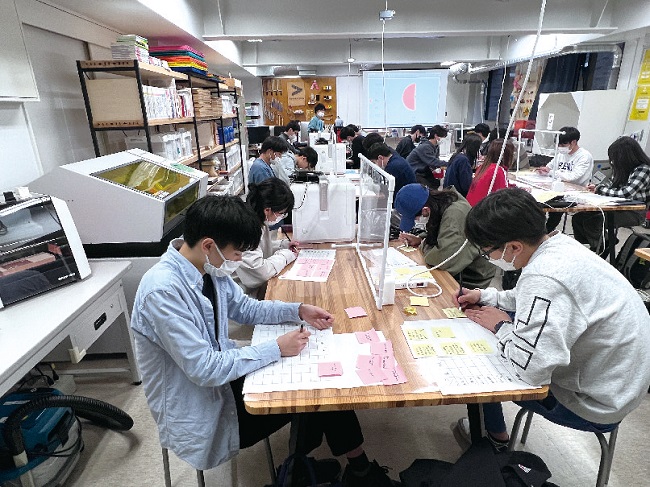When you look into the laboratory, you will see what looks like a mechanical workshop.As you go deeper, you will see a giant pill bug made of blue plastic.The owner of this mysterious space where informatics, engineering, and biology come together is Professor Naohisa Nagatani, whose research ranges from human senses and perceptual expansion* to the senses of living things.We would like to introduce some of our diverse research and education.
*Using technology to expand sensory perception functions

From creating human-like robots to insect research
When I was a student, I was enrolled in the Department of Intelligent Mechanical Engineering at the University of Electro-Communications, from undergraduate to doctoral level.Perhaps influenced by Doraemon, who I admired when I was an elementary school student, I became interested in creating human-like robots, which led me to pursue a career in research.However, at that time, artificial intelligence was not as developed as it is now, so I joined a laboratory that uses VR to investigate the human senses and perceptions that are responsible for human-like "movement."Here, we conducted research to expand sensations and perceptions by applying specific electrical stimulation, but since this is an engineering department, we not only measure people's sensations, perceptions, and actions, but also carry out the necessary experiments. They also made equipment.
After researching humans for a long time, I felt that in order to deeply understand human nature, it was necessary to make comparisons with other living things, and then I realized that the laboratory I belonged to before coming to our university was conducting research on ants. I also started observing the behavior of ants, pill bugs, etc.Since then, although I am not a biological researcher, I have included the behavior of insects in my research, and have developed observation devices specifically for insects, such as the VR experimental device ``ANTAM.''
Is it controlled by insects?ANTAM was born from a reversal idea.
Research on insect behavior observation has a long history, but we are trying to obtain new knowledge by introducing quantitative methods based on data measurement to behavioral observation that has traditionally been done visually. That's what I think.The device we devised for this purpose is ANTAM.In addition, in the improved version of ANTAM-Q, insects are placed on a rotating transparent sphere, their movement behavior is captured with a camera from the back side (ventral side), and feature points such as legs and antennae are extracted and tracked. Collect behavioral trajectories and movement data similar to natural environments.
Today, deep learning is progressing rapidly, and the data obtained can be automatically quantified with a high degree of accuracy, allowing us to see even minute movements that could not be captured before. I hope that knowledge that was established some time ago can be rewritten.

VR experimental device “ANTAM”
What is the scientific value of creating “motion specimens”?
By using ANTAM, it is possible to quantify behavior and obtain more detailed behavioral data, which is not only useful for the development of insect robots that can be used at disaster relief sites, but also as a "movement specimen". I think it's worth it too.
One is scientific value.For example, pill bugs may walk differently in a few decades, so recording their current movements should have natural history value.Classification of biological species is usually based on shape and DNA, but movement data may also become a new standard.Would it be an exaggeration to say that it has value as an intellectual asset for humanity?
Another application is entertainment.Utilize motion samples for animation and game modeling.Motion capture of people is not uncommon, but what about motion capture of insects? If ANTAM can collect data on the movements of many species, creators may no longer need to model movements from scratch to make insects move.Furthermore, by analyzing the accumulated data, it may be possible to create avatars that move in a metaverse space that is close to reality, or to elucidate the perception of insects in detail and enjoy the ``insect's perspective''.Doesn't it remind you of Doraemon's world with secret tools?
Continuation of arts and crafts, manufacturing class
One of the classes I teach is ``Digital Fabrication,'' which is offered in the fall semester of my first year.Since it is fabrication, we use 1D printers, laser cutters, etc. to produce it. You will also learn how to draw and design using a computer called CAD.My design teacher and I are in charge of the project, and we even create things similar to what you would expect from an art university, such as designing smart speakers. It may be difficult for first-year students to fully understand the details of the work theoretically, but when the 3D printer prints out the model they created using CAD, they all seem to be happy and say, ``This is what I've been doing since elementary school drawing!'' .I often say, ``Don't worry about failure, let's remember the fun that time once again.''The intensive lectures are held on Saturdays, making the classes somewhat difficult for both the students and the instructors, but the students' satisfaction levels are very high and the classes are rewarding.The number of students who have taken this class has joined my laboratory has increased, and their creations have won prizes at the IVRC (Interverse Virtual Reality Challenge)* and been exhibited at a VR event held in France. I have even won awards.
*A challenge that has been going on since 1993, in which teams of mostly students plan and produce interactive works.
Towards inquiry learning - Cherishing the spirit of independent research -
As I continue my research, I am greatly inspired by the independent research of elementary, middle school, and high school students.I think it's because a lot of things come from simple curiosity, just like the excitement of arts and crafts.Regarding pill bugs, there is a lot of behavioral research being done by the general public, and there are many interesting ones that have been highly rated in elementary and junior high school independent studies and high school biology contests.I am honestly impressed by the research conducted by high school students who focused on the fact that mold does not easily grow near the rearing cases where pill bugs are kept, and discovered that the droppings contained anti-fungal ingredients. I am forced to do so.
Compared to this, my research is simply digitizing simple research that can be done with elementary school level knowledge. Although it may be technically difficult to create a device like ANTAM, the idea was very simple: what if we looked at insects from the ventral side, which we don't normally see?However, we were able to analyze the movement of the legs in more detail, and it turns out that the legs are used to defecate!There were also new discoveries.It's also interesting to observe familiar creatures from a different perspective than usual.

At the "Fab Space" where digital machine tools are available

Associate Professor, Faculty of Information Science and Technology, Kyoto Sangyo University
Naohisa Nagatani
Born in 1982. In 2011, withdrew from the University of Electro-Communications Graduate School of Electrical and Communications Engineering after completing the doctoral course. Ph.D. (Engineering) in 2012.He is a special research fellow (DC1) of the Japan Society for the Promotion of Science.He served as a specially appointed research assistant professor at the Graduate School of Information Science and Technology at Tohoku University and a postdoctoral researcher at the Disaster Prevention Technology and Social Systems Research Center at Hachinohe Institute of Technology.He became an assistant professor at the Department of Computer Science and Engineering at Kyoto Sangyo University in April 2015, and has been in his current position since 4.He is engaged in research on sensory augmentation interfaces that utilize human sensory perceptual characteristics and behavioral analysis of arthropods.He graduated from Sendai Daiichi High School in Miyagi Prefecture.

